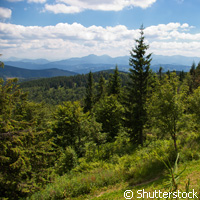Trees can fight poor light with more carbon intake
If you ever thought that poor sunlight levels play havoc with trees' photosynthesis process, think again. New research from the Czech Republic shows how trees have the capacity to adapt to light conditions and boost their intake of carbon for photosynthesis in poor light. The study, which put the spotlight on how cloud cover affects photosynthesis, is presented in the journal Functional Ecology. No matter how hard they try, clouds cannot dim the evergreen of European forests. This is in contrast to Asian jungles that are usually overshadowed by a dense canopy. Photosynthesis gives plants and trees the means to take in carbon and use the solar energy to generate oxygen. This process needs sunlight. The surface of our planet receives energy from the Sun directly or through the atmosphere by a myriad of factors like cloud cover. 'Cloud cover has a direct impact on ecosystems by influencing temperature and light, so the conditions of the sky are just as important to photosynthesis as sunlight itself,' explains Dr Otmar Urban of the Global Change Research Centre in Brno, Czech Republic, who is the lead author of the study. 'Surprisingly, however, studies show that an increase in cloud cover and the resulting diffusion of light can actually enhance the photosynthesis of forest canopies, but the mechanism behind this has remained unknown.' While some people may think it odd that greater cloud cover could increase an ecosystem's carbon swap through photosynthesis, the Czech team suggests the process is triggered by a balanced distribution of light among leaves across various levels of a forest canopy. For the purposes of this study, the researchers evaluated the net intake of a spruce forest in the Czech-based Beskydy Mountains under both sunny and cloudy skies. They also assessed the leaf chlorophyll within various sections of the canopy to measure the resulting levels of photosynthesis. The data reveal that there is an increased uptake of carbon across the ecosystem when there is a higher diffusion of sunlight during cloudy days. This was in comparison to the same levels of light on sunny days, according to the team. The researchers found that tree shoots from deep within the canopy influenced the total carbon balance of the forest when the sky was grey. But when the sky was bright and shiny, the contribution of middle or shaded parts of the canopy was either marginal or negative. Shoots at the top of the canopy contributed more than three quarters of the overall carbon intake during a sunny day, but just 43% during a cloudy day when light was more evenly distributed. 'This research shows that diffuse light, caused by cloud cover, has an important impact on the productivity of vegetation,' Dr Urban says. 'The ability of forests to not only adapt to the levels of light they regularly receive, but make effective use of those conditions, helps us to understand how individual trees can maintain such a high intake of carbon despite being overshadowed by the tops of the canopy.'For more information, please visit: Functional Ecology: http://www.functionalecology.org/view/0/index.html(opens in new window) Global Change Research Centre: http://www.czechglobe.cz/(opens in new window)
Countries
Czechia



